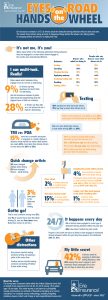
By: Mark Segerstrom
I recently saw an overpass sign from the Iowa DOT that read, “Texting & Driving is not Wreckommended.” Clever and to the point! The larger issue is after decades of declining fatalities on our roads, fatality rates are starting to climb again. The reason….driver distractions. The numbers just released on January 5th by the Iowa Department of Transportation, Office of Driver Services showed a 21% increase since 2013. There were 402 deaths just last year. Another way to look at it is to imagine a 747 crashing in Iowa each year. We would not be accepting of that. Why have we become so complacent?
We face so many more distractions in our commute than even just a few years ago. A distraction can be anything that either takes your eyes off the road, hands off the steering wheel or mind off of your driving environment. Common distractions are in-vehicle entertainment systems, electronic billboards, cell phones, wireless devices, children, pets or the meal you just picked up. They all cause a distraction that can be detrimental to you or others.
Erie Insurance published an interesting study in 2015 that compared what drivers admitted to doing behind the steering wheel to what they said they had seen others doing. Thirty percent of drivers admitted to smoking or texting behind the wheel, while 75% said they had seen others performing these same tasks. Eight percent said they had applied makeup, but surprisingly 66% said they had seen others putting on a “new face”. So our perception of what we do does not actually meet the reality of where our attention should be applied.
Consider for example, 28% of drivers in this study admitted to talking on a cell phone during driving, but felt there was nothing distracting about that activity. David Strayer and his team at the University of Utah found, due to cognitive distraction, drivers talking on a cell phone will look at, but not ”see” up to 50% of their driving environment. They tend to miss the red light, the pedestrian walking across the street or the vehicle turning in front of them. They develop tunnel vision. Stayer found that sending a text actually resulted in worse reaction time than driving legally drunk.
So as we move forward in the New Year, let’s make a pledge to be more respectful, responsible and safe drivers. Create a stress-free driving space and anticipate potential hazards. Be aware of anyone traveling in your blind spots and look at your rear view mirrors for traffic behind you. Scan ahead 10-15 seconds and try to leave yourself an out should something arise unexpectedly. Finally, download the app that each major carrier offers as a way to limit and restrict incoming texts and phone calls. Together we can change the trend of rising distracted driving fatalities.

